Agriculture that Balances Prosperity for People with
the Sustainability of the Global Environment:
Kubota’s Vision
for the Future
of Smart Agriculture
The environment surrounding food and agriculture is
currently in the midst of major changes.
The environment surrounding food and agriculture is currently in the midst of major changes. Poor harvests due to climate change and disasters caused by extreme weather are threatening the stable supply of agricultural products and leading to rising food prices worldwide. At the same time, we are also seeing growing disparities in food distribution, with food satiation in the developed world contrasting with widespread hunger in the developing world. Meanwhile, rising geopolitical tensions have brought about a renewed awareness of the importance of food security.
Behind these challenges lie a growing world population, rapid economic development in emerging countries, and changes in the agricultural environment driven by climate change. These circumstances have created an increasing need for smart agriculture, which realizes labor and resource savings and increases agricultural productivity through the use of automated and highly precise farming methods.
What is important, however, is not to rely on one-size-fits-all solutions, but to develop new technologies tailored to the characteristics of each region. As a machinery manufacturer, Kubota is working to expand its business and to conduct research and development on a global scale, while pursuing solutions that meet the needs of each region, including with regard to the economic conditions, development situation, varieties of crops grown, farming methods, and so on. How does Kubota envision the future of agriculture? And, moreover, how is the company working to realize “planetary-conscious” agriculture? To try to answer these questions, Hiroyuki Araki, Executive Officer and Deputy General Manager of the Research and Development Headquarters at Kubota, spoke with Michiaki Matsushima, Head of Editorial Content at WIRED JAPAN.
Their conversation can also be viewed in The Big Interview, a video series on the big future by WIRED JAPAN.

Right side: Hiroyuki Araki, Executive Officer and Deputy General Manager of the Research and Development Headquarters at Kubota
Left side: Michiaki Matsushima, Head of Editorial Content at WIRED JAPAN
The Role of “Automation” in Agriculture
MICHIAKI MATSUSHIMA (MATSUSHIMA) :This year again, Kubota exhibited at the Consumer Electronics Show (CES), which is held in Las Vegas each January. What sort of response did you receive?
HIROYUKI ARAKI (ARAKI) :At this year’s CES, we exhibited KATR*. This machine picked up a Best of Innovation Award at the CES Innovation Awards® 2025, and my feeling is that it attracted a great deal of attention.
*The KATR is the foundation model of the Versatile Platform Robot Type: S, which is currently on display at Expo 2025
Osaka, Kansai, Japan (*). For details of the Type: S and of the separate model Type: V, please click here.
The KATR is a vehicle-type solution that supports agriculture in and around mountainous and hilly areas. It is characterized its ability to keep the transport section horizontal regardless of the terrain conditions. The KATR is designed to operate on sloping terrain, which is very common in mountainous areas, and it employs force control technology to carry loads without dropping them, even when going up or down steep slopes.
MATSUSHIMA :Autonomous driving has become a major trend in the car industry in recent years, but what precisely is the situation with regard to autonomous driving in agriculture?
ARAKI
:We have positioned the automation of agricultural work as one of the key technologies for smart agriculture. We are currently developing what we call the Agri Robo, which is a manned/unmanned agricultural machine equipped with an autonomous driving function, and we place great importance on conducting research from the standpoint of how automobile technology can be applied to agricultural machines.
At the same time, simply automating tasks in a generalized manner is not sufficient in the agricultural sector. There are significant differences in how agriculture is practiced in different countries and regions, and we need to ensure that automation is implemented in ways that match the specific conditions and challenges of each agricultural setting.
MATSUSHIMA :You mentioned that the KATR is designed particularly for use in mountainous areas. How precisely do you intend to provide support in keeping with each region’s unique agricultural practices?
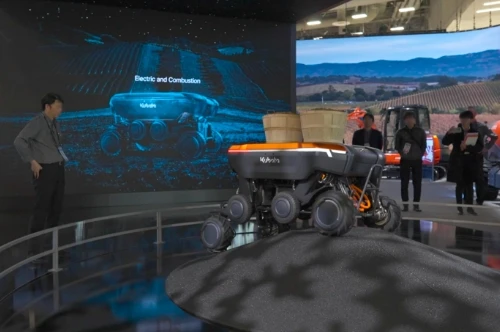
ARAKI
:For instance, we also envision using the KATR in vineyards in the United States, where it would not only be used to transport harvested grapes but also to measure and analyze data. Grapevines are very delicate, and the way the grapes grow is affected even by moderate changes of weather. By sensing each grape individually using near-infrared technology, for example, it is possible to measure indicators such as sugar content, acidity, and tannin levels. We believe this can be of immense help when making decisions concerning different regions, varieties, and harvest times.
It is also important to detect and deal with pests and diseases at an early stage, and we are developing an approach that involves precisely applying pesticides locally to avoid applying excessive amounts to the entire field.
MATSUSHIMA :When we think of the industrialization of agriculture, we immediately conjure up images of the large-scale spraying of pesticides, but the idea you are pursuing seems to be to reduce the overall use of pesticides by employing data-driven micro-control to pinpoint the minimum amounts of pesticide to be applied.
ARAKI :You are absolutely right. For example, conventionally, when even one vine is found to be infected by oidium, a genus of fungi also known as powdery mildew that is major problem in vineyards, a pesticide has to be sprayed over the entire area. But if we could detect its presence and identify the signs early enough, we might be able to significantly reduce the amount of pesticide that needed to be applied.
MATSUSHIMA :What is the current state of drone-based sensing in data collection?
ARAKI :The reality is that growth diagnosis based on remote sensing is still at the diffusion stage. However, by using a camera-equipped drone to capture images from above rice paddies and evaluate which areas are growing well or poorly, it is possible to take measures such as applying fertilizer locally to areas where growth is poor.
A Platform for Balancing a Stable Food Supply with
Region-specific Agriculture
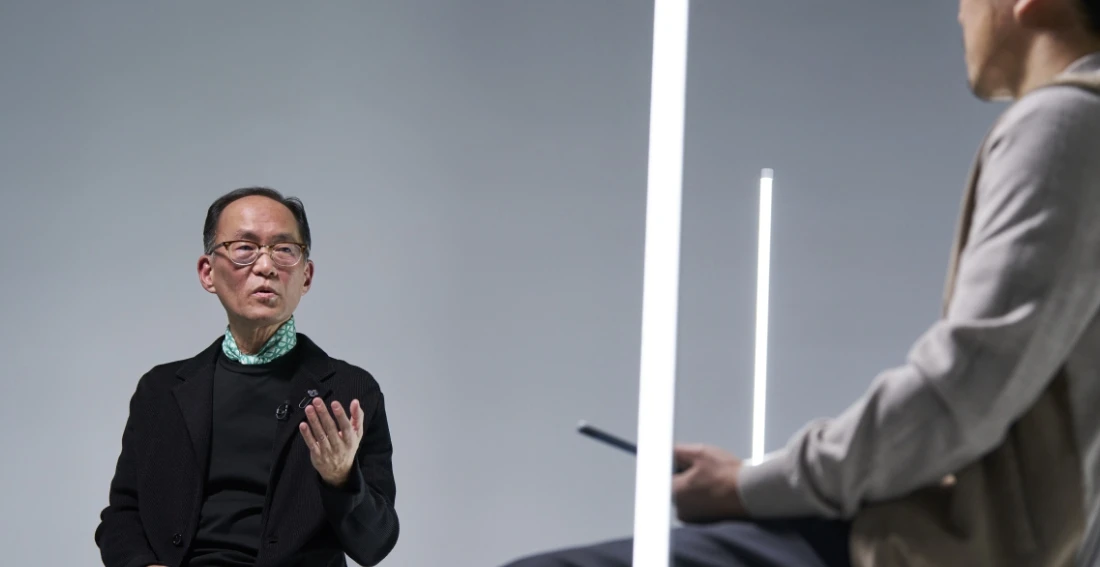
MATSUSHIMA :What kind of data will be important to provide solutions tailored to local agriculture?
ARAKI :Data on soil and biological information will be crucial. This information, including data on genomics (the study of an organism’s complete set of genes, or genome) and phenomics (the study of an organism’s physical and biochemical traits, or phenotype), which allows us to assess trends and growth conditions that appear in plants, will be very important in making optimized agricultural decisions.
MATSUSHIMA :You are also currently providing the Kubota Smart Agri System (KSAS), which is a digital platform that utilizes such data, aren’t you?
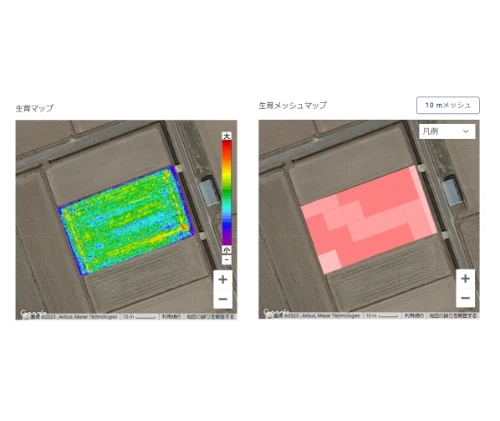
ARAKI
:That’s right. KSAS is an agricultural management support system we developed in 2014 that allows farmers and agricultural service providers to work together via the Internet. KSAS comprehensively manages data collected by machines along with remote sensing image data, and data on weather and soil conditions, and also accumulates and analyzes data on field management, work records, yield, eating quality, and moisture content. The system works in concert with Kubota’s agricultural machinery to help improve working efficiency while maximizing the yield and quality of crops.
For example, when a combine harvester is harvesting rice, it automatically collects information on such things as the moisture content, protein content, and yield of the crop, and
uploads the data to a cloud system. The protein content of rice is a very important indicator because it is directly related to the rice’s flavor, and there is considerable value in being able to monitor this indicator on an area-by-area basis.
MATSUSHIMA :Perhaps it is also possible to estimate the harvest time from this information?
ARAKI :You are absolutely right. In fact, we also provide a function that uses AI to predict the optimal times for planting and harvesting rice based on the weather conditions. This is extremely important given that many of today’s rice farmers are managing a large number of dispersed paddy fields.
MATSUSHIMA :When we talk about smart agriculture, the emphasis tends to be on how it can substantially increase the productivity of large-scale farming, but I think what you are also saying is that the act of changing the solutions to suit the local area and conditions is the gateway to smart agriculture.
ARAKI :As a machinery manufacturer, we have been taking a global approach to solving the problem of improving the productivity of large-scale farming. This is an essential element from the perspective of food security. With some predictions suggesting that the number of farming households in Japan will decline from around 2 million to around 300,000 in 20 years’ time, supporting farmers who are engaged in large-scale farming operations is becoming an increasingly important issue.
At the same time, we believe it is essential to understand local ecosystems and customs, the crops that can be harvested, and above all, the thoughts and knowledge of local farmers, in the interests of realizing smart agriculture that can customize the base technologies to suit to local conditions.
Even in countries and regions that cannot afford to fully adopt smart agriculture due to economic reasons, it will still be possible for farmers to utilize some aspects of smart agriculture by providing data that will help to realize agriculture that is suited to the local land conditions. For example, in regions with rapidly growing populations such as sub-Saharan Africa, where 63% of the population live in rural areas and many are small-scale farmers, we believe that effective agriculture can be achieved as long as we can provide crop cultivation profiles.
Realizing “Planetary-conscious” Smart Agriculture

MATSUSHIMA :In sub-Saharan Africa, soil fertility is declining as a result of over-cultivation driven ultimately by population growth. It is also essential to tackle the issue of being unable to guarantee sufficient productivity to feed the constantly-growing population. What this means is that we have to try to ensure a stable food supply while at the same time preserving the global environment and ecosystems. I think that the “planetary-conscious” concept that Kubota is promoting at Expo 2025 Osaka, Kansai, Japan expresses this sense of challenge.
ARAKI :The “planetary-conscious” concept expresses a state in which an affluent society and a sustainable global environment are both achieved, in contrast to the “planetary boundaries” concept, which emphasizes the limits of the Earth. As the world approaches an era in which the human population may reach 10 billion, how can we reconcile the two potentially conflicting elements of natural ecosystems and artificial resource recycling? Since eating is the essence of life, we felt that the keyword “planetary-conscious” was appropriate as a way of expressing our intention to use our knowledge and technology to cultivate various “seeds” that will nurture life in the future.
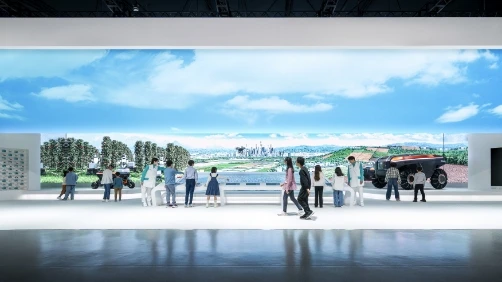
MATSUSHIMA :As forms of agriculture that are more in harmony with nature, organic farming and environmentally regenerative farming, both of which focus on the health of the soil, are attracting a lot of attention. Is smart farming an approach that can coexist with these approaches? ARAKI :The aspect of smart agriculture has been most strongly emphasized up to now is its potential as a method for efficiently and optimally securing food in the era of explosive population growth. Of course, this remains one of the world’s most pressing issues, but the essence of smart agriculture is actually to identify methods that are well suited to various ways of farming. In addition to ensuring efficient yields to support the current population of 8 billion people, it is also necessary to support small-scale, high-quality crop production. Using data and AI to propose appropriate farming methods to protect natural ecosystems through smart agriculture should be extremely beneficial for small-scale organic farmers. We believe that organic farming, environmentally regenerative agriculture, and smart agriculture can function in a mutually complementary manner.
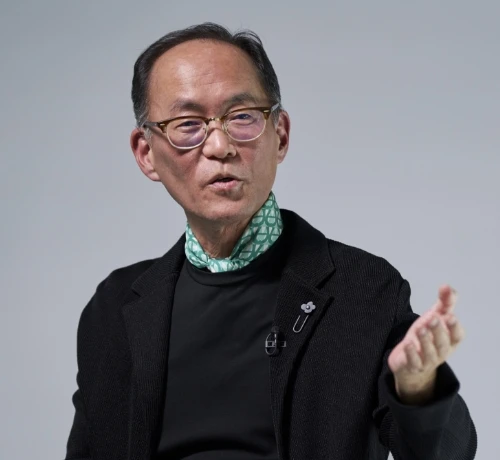
MATSUSHIMA :Specifically, what kind of data can be used?
ARAKI :For example, by providing farmers who practice organic farming with soil sensing technology and digitally quantifying the diversity of microorganisms and the state of organic matter decomposition, it will be possible to achieve more effective cultivation management. Precision farming technology can also be used to help determine the optimum amounts and timing of organic fertilizer application. ARAKI :Furthermore, if it becomes possible to measure the effects of environmental restoration activities based on data, I believe we will be able to move forward with the goals of environmentally regenerative agriculture by providing scientific support. There is tremendous potential for the use of sensors that visualize soil microbial activity to improve soil health, and technology that measures soil carbon accumulation to reduce greenhouse gases through carbon fixation in the soil.
MATSUSHIMA :I see. So, you are saying that the technologies of smart agriculture can function as a more scientific and efficient means of practicing organic and environmentally regenerative agriculture.
ARAKI :Yes, that’s right. We believe that the pursuit of smart agriculture will lead to environmentally regenerative agriculture. Although there are different approaches, we believe that with the proper use of technology, we can contribute to the common goal of producing all the food we need while reducing the burden we place on the environment.
MATSUSHIMA :When discussing the Earth’s ecosystem services, it is often mentioned that we humans know a lot about what is above ground and about what we can grasp from a bird’s eye view, but we still know very little about what is below ground, or in other words, what is in the soil. Do you feel that technology is deepening our understanding of the soil, which is essential to the evolution of smart agriculture?
ARAKI :The truth is that the soil is still largely uncharted territory. Although chemical information (on nutrients like nitrogen, phosphorus, and potassium, and on pH, etc.) and physical information (sandy versus clayey, etc.) are currently being digitized, much more research needs to be done to assess “soil health.” We need more research in order to determine what kind of soil microorganisms are necessary for healthy soils and crops, and what kind of environment is favorable for microorganisms.
A Little Bit About the Future of Agriculture

MATSUSHIMA :Can you tell us some more about the future? A quantum computer expert told me the other day that one of the essential changes that occurs when we shift from analog to digital (and then to quantum) involves “simulations.” Farmers may only plant crops a few dozen times in the course of a lifetime, but as simulations become more sophisticated, they will be able to run tens of thousands of simulations in a single night. Do you think such a thing will ever become possible?
ARAKI :For example, by precisely representing the sunlight and weather conditions in digital space and simulating the optimum harvest time and crop quality, farmers will be able to make accurate forecasts along the line of, “Under these conditions, we will have a good harvest this year.”
In the development of agricultural machinery, there has been an evolution away from the previous method of building large numbers of prototypes and evaluating them on actual equipment and toward the use of simulation technology. It is now possible to use simulations to predict strength calculations, comfort, component life, and other factors.
The essence of smart agriculture, with data at its core, is all about enabling people with the knowledge to produce better crops than they themselves could have envisaged, and creating an environment in which agriculture is democratized so that even people with no intuition or previous experience can get involved.
MATSUSHIMA :With the continuing progress of data collection and technology, future generations will come to understand the mechanisms of nature and plants better than we do. This may be the seed of future life that Kubota is searching for.
ARAKI :As a global company, our goal is to provide the world with a system that can ensure food security for everybody even if the population reaches 10 billion people, while supporting all kinds of large- and small-scale farmers and the production of crops in each region. The preconditions for this are to reduce the burden we place on the Earth and deliver food in a sustainable manner. In order to develop technologies and provide products that can overcome this high hurdle, we would like to contribute to a planetary-conscious agricultural system while keeping track of diverse data on a global scale.